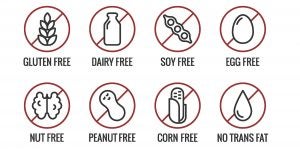Have you been grocery shopping lately? If so, it probably won’t come as much of a surprise that so-called “free-from” labels are one of the fastest-growing food marketing trends. These food labels focus on what’s not in our food, rather than what is in it.
The biggest growth in these labels comes from gluten-free (up 24%), no antibiotics (up 20%), soy-free (up 19%), and hormone and antibiotic-free (up 15%). The free-from bandwagon sometimes takes a little more effort for manufacturers than, say, slapping a “natural” label on the product. But manufacturers are implementing changes to make it work.
Why are we more concerned about what’s not in our food than what is in our food?
Unless an eater legitimately has a medical condition prohibiting her from consuming one of these items (Celiac’s disease being the most obvious), we should be more concerned about the nutritional content of food. We should worry about whether we’re eating a balanced diet, not successfully avoiding specific foods, ingredients, or production methods.
Registered Dietitian Kim Melton of Nutrition ProConsulting agrees. “Eating a healthy diet is about balance, not necessarily restriction,” she said. “If you take out an entire food group (say dairy), you’re missing out on the nutrients from dairy, including protein, calcium, B vitamins, and vitamins A and D.”
For agriculture, the situation is more acute. As these trends grow, they ultimately start to impact how we farm. If consumers demand GMO-free foods in the marketplace, processors and manufacturers start to make the same demands on farmers.
We’re already seeing this take shape. Cargill partnered with The Non-GMO Project for verification of the grain it buys. But Cargill experienced problems filling that demand and offered price premiums to farmers willing to pledge it non-GMO crops. The demands for GMO-free products has flowed directly from activist organizations all the way back to the farm, which was always the goal.

Unfortunately, our fixation with the free-from labels doesn’t mean we’re making healthier choices. It doesn’t mean the products offered with those labels are any more nutritious. It doesn’t mean the food is better quality or better for us.
It’s like buying cigarettes labeled non-GMO because they’re supposedly healthier.
As a registered dietitian Kim shares this concern, specifically for people following a gluten-free diet when they haven’t been diagnosed with a medical condition making that necessary.
“Taking gluten out of your diet means reducing your dietary fiber intake, which has been found to prevent disease,” she explained. “In fact, data from the Nurses Health Study found higher rates of diabetes in healthy individuals following a gluten-free diet when they didn’t need one.”
So, what the heck are we doing?
The problem stems from a society always looking for the next best way to solve our dietary and health problems. We want to lose weight, but we don’t want to cut calories. We want less back pain, but we don’t want to stretch daily. We more energy, but we don’t want to exercise. We want the easy way out. We want the simple solution.
The free-from labels, as well as the myriad of other health food trends, are the result. We find another boogeyman to blame. In reality, these labels are just another symptom of a scientifically illiterate society looking for quick fixes.
Unfortunately, that doesn’t always mean we’re making the best choices for ourselves, our families, or the environment. And when those frivolous decisions start to dictate how we produce food, we have a major problem.
Amanda Zaluckyj blogs under the name The Farmer’s Daughter USA. Her goal is to promote farmers and tackle the misinformation swirling around the U.S. food industry.



